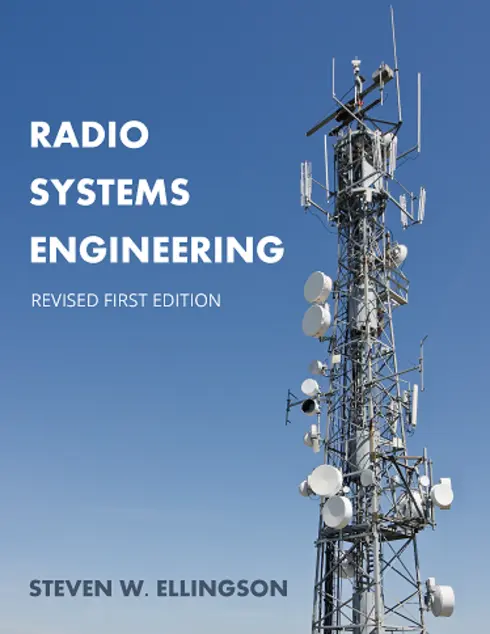
Radio Systems Engineering - Revised First Edition
![]()
![]()
![]()
![]()
![]()
Steven W. Ellingson, Virginia Tech
Copyright Year:
Publisher: Virginia Tech Publishing
Language: English
Formats Available
Conditions of Use
![]() Attribution-NonCommercial
Attribution-NonCommercial
CC BY-NC
Reviews
Reviewed by Dimitrie Popescu, Professor, Old Dominion University on 5/9/25
This is a comprehensive textbook that teaches operating principles and practical implementations of radio communication systems. The textbook topics cover: - Fundamental concepts on radio frequency (RF) spectrum, antennas, and electromagnetic wave... read more
![]()
![]()
![]()
![]()
![]()
Reviewed by Dimitrie Popescu, Professor, Old Dominion University on 5/9/25
Comprehensiveness
This is a comprehensive textbook that teaches operating principles and practical implementations of radio communication systems. The textbook topics cover:
- Fundamental concepts on radio frequency (RF) spectrum, antennas, and electromagnetic wave propagation (Chapters 1, 2, 3).
- Operational considerations in the presence of noise and RF link analysis (Chapters 4, 7)
- Analog and digital modulation schemes for information transmission (Chapters 5, 6)
- Detailed discussions of circuit and implementation aspects (remaining chapters 8-18).
Content Accuracy
All chapters include accurate coverage of presented topics that is supported by mathematical details and arguments.
Relevance/Longevity
Topics presented in the textbook cover the fundamental principles of radio communication systems and will not become obsolete anytime soon. Characteristics of some existing (and currently common) radio systems are given in Appendix B, which is the only part of the textbooks that may require an eventual update in the future.
Clarity
The textbook is written in a prose that is accessible to upper-level students majoring in electrical engineering and/or computer engineering students and professionals working in the field of radio communication systems. However, it is not self-contained, and readers should be familiar with prerequisite knowledge on circuits, signals and systems, and electronic circuits.
Consistency
Terminology and notations appear to be consistent throughout the textbook and they follow vocabulary and variable names commonly used in electrical and computer engineering.
Modularity
Chapters are focused on specific topics and each chapter is divided into sections that can be covered in distinct lectures or could be assigned as reading material to students in preparation for lectures or as a study guide.
Organization/Structure/Flow
Chapters are presented in a logical sequence, starting from simple concepts that are fundamental to understanding the operation of radio communication systems, and moving on to more advanced concepts and applications used in practical systems.
Interface
The textbook is available as a PDF file with built-in navigation features. The functionality of these features depends on the software used to view the PDF file, but basic clickable links seem to work on both Windows and Mac OS systems.
All the original figures and diagrams in the textbook are of excellent quality and serve as meaningful visual aids in the presentation. There are a few figures reprinted with permission from other references, which are not of the same high quality, but these figures still serve the purpose providing visual aids in the presentation.
Grammatical Errors
The textbook contains no grammatical errors.
Cultural Relevance
This is an engineering textbook that has no culturally insensitive or offensive content.
CommentsI have enjoyed reviewing this book and, in my opinion, it can be considered for adoption as textbook in an engineering course on wireless communication systems. However, some topics that are usually taught in such a course are not included in this book and one will have to find alternative resources. These topics include multiple access techniques and cellular concepts, and are relevant to modern radio communication systems.
Table of Contents
- Introduction
- Antenna Fundamentals
- Propagation
- Noise
- Analog Modulation
- Digital Modulation
- Radio Link Analysis
- Two-Port Concepts
- Impedance Matching
- Amplifiers
- Linearity, Multistage Analysis, and Dynamic Range
- Antenna Integration
- Analog Filters & Multiplexers
- Frequency and Quadrature Conversion in the Analog Domain
- Receivers
- Frequency Synthesis
- Transmitters
- Digital Implementation of Radio Functions
- Appendix A: Empirical Modeling of Mean Path Loss
- Appendix B: Characteristics of Some Common Radio Systems
About the Book
Using a systems framework, this textbook provides a clear and comprehensive introduction to the performance, analysis, and design of radio systems for students and practicing engineers. Presented within a consistent framework, the first part of the book describes the fundamentals of the subject: propagation, noise, antennas, and modulation. The analysis and design of radios including RF circuit design and signal processing is covered in the second half of the book.
Key features
- Numerous examples within the text involve realistic analysis and design activities, and emphasize how practical experiences may differ from theory or taught procedures.
- RF circuit design and analysis is presented with minimal involvement of Smith charts, enabling students to more readily grasp the fundamentals.
- Both traditional and software-defined/direct sampling technology are described with pros and cons of each strategy explained.
Radio Systems Engineering (Revised First Edition) was previously published by Cambridge University Press (2016) ISBN 9781107068285. This version is © Steven W. Ellingson and has been lightly updated to correct known errata, minor issues with text and figures, and to present examples in color highlight boxes and some figures in color. It is made freely available and under a Creative Commons Attribution NonCommercial International License (CC BY NC 4.0) with permission from Cambridge University Press.
About the Contributors
Author
Steven W. Ellingson is an Associate Professor of Electrical & Computer Engineering at Virginia Tech. He received the Ph.D. degree in Electrical Engineering from the Ohio State University. He held senior engineering positions at Booz-Allen & Hamilton, Raytheon, and the Ohio State University ElectroScience Laboratory before joining the faculty of Virginia Tech. His research is in the areas of antennas and propagation, applied signal processing, and radio frequency instrumentation, with funding from the U.S. National Science Foundation, National Aeronautics and Space Administration, the Defense Advanced Research Projects Agency, and the commercial communications and aerospace industries. Dr. Ellingson serves as a consultant to industry and government on topics pertaining to radio frequency system design.
